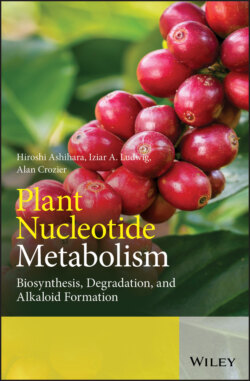Читать книгу Plant Nucleotide Metabolism - Hiroshi Ashihara - Страница 52
4 Purine Nucleotide Biosynthesis De Novo 4.1 Introduction
ОглавлениеThe de novo biosynthesis of purine nucleotides was elucidated independently by Buchanan and Greenberg in the 1950s (see, Buchanan 1986). The purine ring is assembled from several small molecules, namely, glycine, glutamine, aspartate, 5-phosphoribosyl-1-pyrophosphate (PRPP), 10-formyl tetrahydrofolate, and carbon dioxide. In the early studies pigeon liver was used, because birds synthesize purines from excess amino nitrogen, the purines are then degraded to urate and excreted. Incorporation of individual precursors into different atoms of urate was used to reveal the purine biosynthesis pathway. Similar precursor feeding studies were performed with leaves of coffee and tea which accumulate the caffeine (Anderson and Gibbs 1962; Proiser and Serenkov 1963). In plant purine studies, N2-fixing root nodules of tropical legumes have been used as experimental material to investigate de novo purine biosynthesis. Substantial amounts of ureides are produced as the major nitrogen-containing compounds derived from purine nucleotides (Schubert and Boland 1990).
Arabidopsis thaliana is a popular model organism in plant biology and genetics. It was the first plant genome to be sequenced, completed by the Arabidopsis-Genome-Initiative (2000). The most up-to-date version of the A. thaliana genome is maintained by the Arabidopsis Information Resource (TAIR). Although feeding experiments and detailed analysis of native enzymes of A. thaliana are difficult from a practical perspective, nucleotide metabolism research has developed aided by molecular genetic studies with the available sequence information from Arabidopsis and rice genomes, confirming the hypothesis that purine biosynthesis de novo in plants is essentially the same as that operating in microorganisms and animals (van der Graaff et al. 2004; Zrenner and Ashihara 2011). However, based on the genome sequence in A. thaliana, the genomic and pathway organization of purine biosynthesis in plants appears to be different from that occurring in other organisms. Plant organization seems to be somewhat similar to prokaryotes, but greater differences are found with higher eukaryotes such as Drosophila, chickens, and humans.
Prokaryotes, such as Escherichia coli, have single genes coding monofunctional proteins except for the purH gene which encodes the bifunctional protein 5-aminoimidazole-4-carboxyamide ribonucleotide formyl transferase/inosine-5′-monophosphate (IMP) cyclohydrolase (ATIC, steps 9 and 10, in Table 4.1). Eukaryotes contain single genes encoding mono-, bi- and trifunctional proteins (Smith and Atkins 2002; van der Graaff et al. 2004). The de novo purine biosynthesis pathway in plants consist of monofunctional proteins, except for the bifunctional enzymes AIRC (pur6) and ATIC (pur9/10) (see Table 4.1).
Table 4.1 Summary of enzymes involved in the purine biosynthesis de novo in plants.
| Genea) | ||||||
| Step | Enzyme name | EC | Abbreviation | Plant | E. coli | TAIR locus |
| 1 | 5-Phosphoribosylpyrophosphate amidotransferase | 2.4.2.14 | PRAT1 | pur1 | purF | AT2G16570 |
| PRAT2 | AT4G34740 | |||||
| PRAT3 | AT4G38880 | |||||
| 2 | Glycineamide ribonucleotide synthase | 6.3.4.13 | GARS | pur2 | purD | AT1G09830 |
| 3 | Glycineamide ribonucleotide formyl transferase | 2.1.2.2 | GARFT | pur3 | purN | AT1G31220 |
| 4 | Formylglycinamide ribonucleotide amidotransferase | 6.3.5.3 | FGAMS | pur4 | purL | AT1G74260 |
| 5 | 5-Aminoimidazole ribonucleotide synthetase | 6.3.3.1 | AIRS | pur5 | purM | AT3G55010 |
| 6 | 5-Aminoimidazole ribonucleotide carboxylase | 4.1.1.21 | AIRC | pur6 | purEK | AT2G05140 AT2G37690 |
| 7 | 4-(N-Succinocarboxamide)-5-aminoimidazole synthetase | 6.3.2.6 | SAICARS | pur7 | purC | AT3G21110 |
| 8 | Adenylosuccinate lyase | 4.3.2.2 | ASL | pur8/12 | purB | AT1G36280 AT4G18840 |
| 9 | 5-Aminoimidazole-4-carboxyamide ribonucleotide formyl transferase | 2.1.2.3 | AICARFT | pur9/10 | purH | AT2G35040 |
| 10 | IMP cyclohydrolase | 3.5.4.10 | IMPCH | pur9/10 | purH | AT2G35040 |
| 11 | Adenylosuccinate synthetase | 6.3.4.4 | ASS | pur11 | purA | AT3G57610 |
| 12 | Adenylosuccinate lyase | 4.3.2.2 | ASL | pur8/12 | purB | AT1G36280 AT4G18840 |
| 13 | IMP dehydrogenase | 1.1.1.205 | IMPDH | gua13 | guaB | AT1G79470 AT1G16350 |
| 14 | GMP synthetase | 6.3.5.2 | GMPS | gua14 | guaA | AT1G63660 |
a) Gene designations used for plants and E. coli are shown. The plant gene names are according to Senecoff et al. (1996). The gene names used for E. coli are also often used in plant literature.
The A. thaliana genes involved in purine biosynthesis are organized either as single genes or small gene families. PRPP amidotransferase which catalyses the first step in this pathway is encoded by at least three genes of the same family. In addition a small gene family, pur6, pur8/12, and gua13, are each represented by two genes in the Arabidopsis genome (see Table 4.1).
